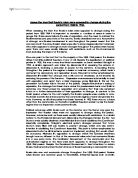Assess the view that the lives of the peasants in Russia did not improve in the period from 1855 to 1964.
Assess the view that the lives of the peasants in Russia did not improve in the period from 1855 to 1964.
When assessing the view that the lives of the peasants did not improve throughout the 1855-1964 period, several key factors must be taken into consideration. These include their living and working conditions, policy towards them, the educational opportunities available to them and the political representation they had under Tsarist and Communist Governments. Once all of these factors have been taken into consideration, it becomes clear that the peasantry did not enjoy a prominent time under Tsarist or Communist Governments, and their lives did not improve in the period.
For the majority of the period, living conditions for the average peasant remained uniformly bleak. Prior to 1917, accommodation was often of a low standard as demand outstripped supply following an influx to the cities, such poor living conditions had a detrimental effect on their quality of life which was also evident under the communists, where living conditions remained in an equally bad, if not worse state compared to the Tsars. Despite Khrushchev continuing Stalin’s efforts to build more social housing and improve the situation, these were often of poor quality and hastily built. This meant that the peasantry did not see any real increase in living conditions between 1855-1964.
In contrast to the lack of interest regarding living conditions, sweeping reforms were introduced under the communists that aimed to improve working conditions for the peasantry. Investment was made in new agricultural techniques with mixed success as Stalin realised that agriculture had to be used in order to boost industry, much like Stolypin before him. In contrast, under the Tsars peasants did not have access to such technology, however they were able to set their own pace as to how they worked, and therefore how much they produced. In most cases, this meant they had to work as hard as possible in order to provide food for their families, as well as the requisition squads which Lenin would later introduce in an attempt to improve productivity.
Conditions under Stalin had severely declined compared with Tsarist Governments. Crops were destroyed in protest, livestock was returned to the collectives and after 1936 the effect of the great purges sunk in. The people who could have helped the peasantry improve their quality of life, such as academics and local officials, had been eliminated, in a similar method to the heavy persecution of the intelligenzi as seen under Alexander III. In terms of living and working conditions the peasants were never truly well off, despite Khrushchev’s sympathy with the farmers the improvements in standard of living were not down to him. Procurement prices rose as the state finally realised that they needed to make more of an effort. The main issue of poor quality land which began under Alexander II’s emancipation at the start of the period, had also improved under Khrushchev’s Virgin Land Schemes. When Lenin’s NEP is also considered, the peasants were free to sell their excess production and this extra money was designed to help the standard of living, although the low procurement prices and in particular the scissors crisis put pay to that despite the markets being better and taxes being reduced in Lenin’s reign. Lenin and Khrushchev were both making advances in the right direction in terms of helping the peasantry, however when considering communist Governments as a whole the horrific effects of the ‘dekulakisation’, purges and enforced collectivisation under Stalin far outweigh the positive effects of the other communist leaders within the period, resulting in a better, albeit still not great, lifestyle for the peasantry under tsarist governments in terms of living and working conditions. So if anything, the lives of the peasants in Russia had got worse in the 1855-1964 period rather than improved.

This is a preview of the whole essay
Teacher Reviews
Here's what a teacher thought of this essay
This response considers many aspects of peasants' lives and is analytical throughout, with good understanding shown. However, it is general in places without enough detail in the evidence to help support points. 4 out of 5 stars.







